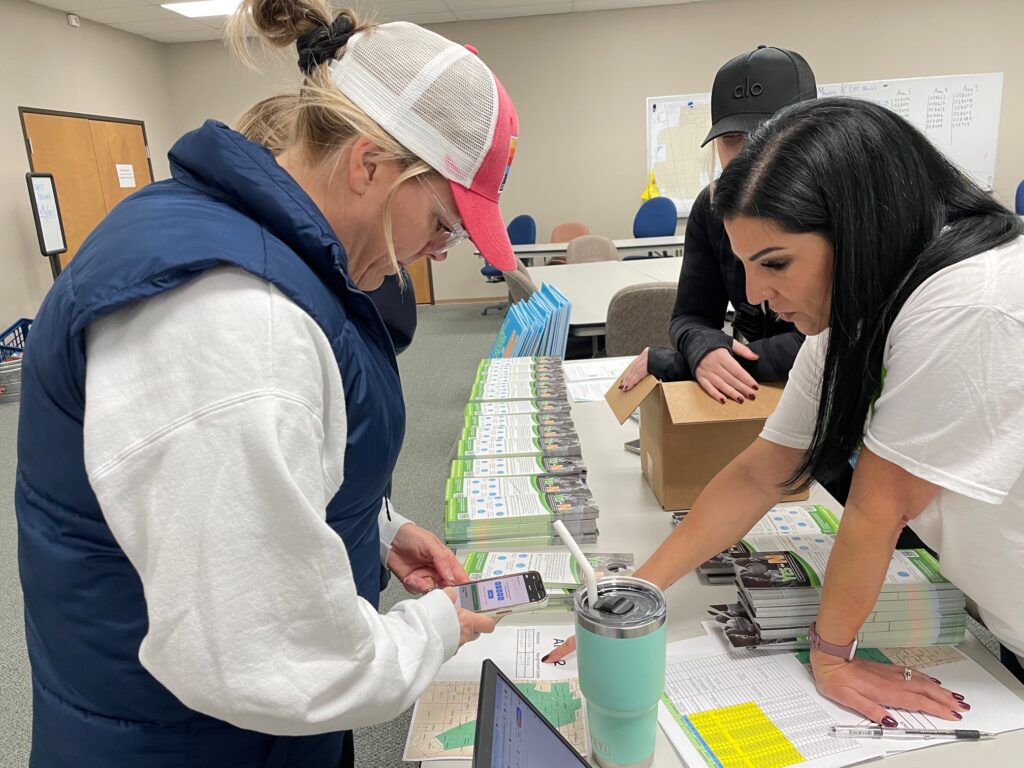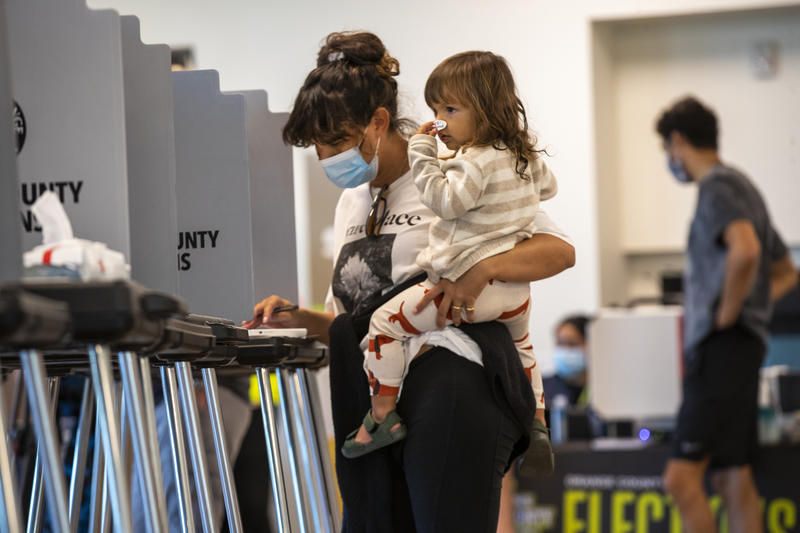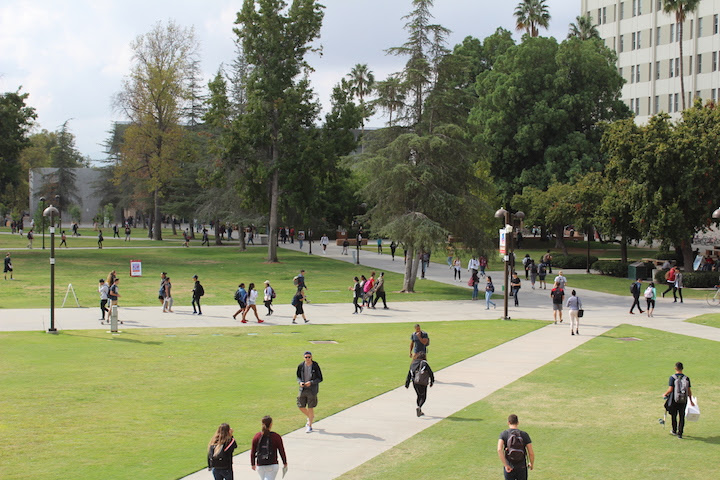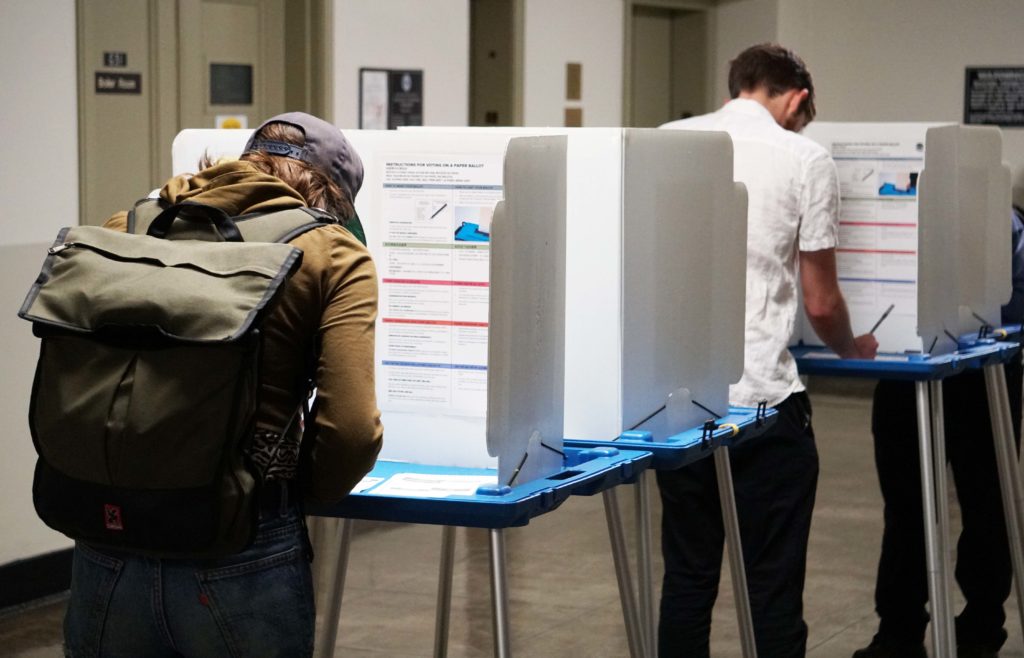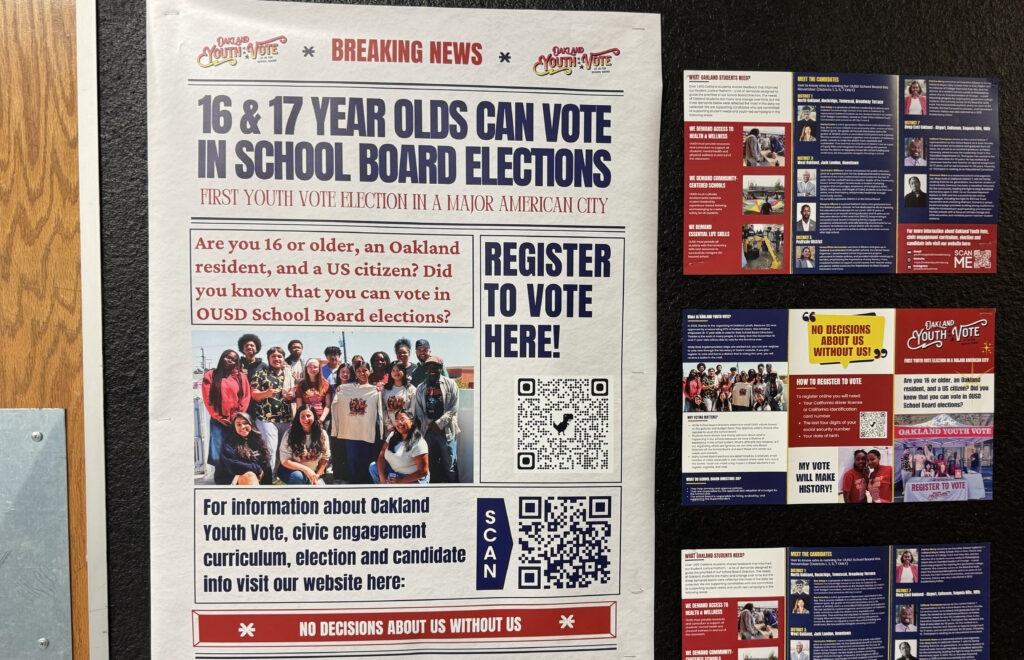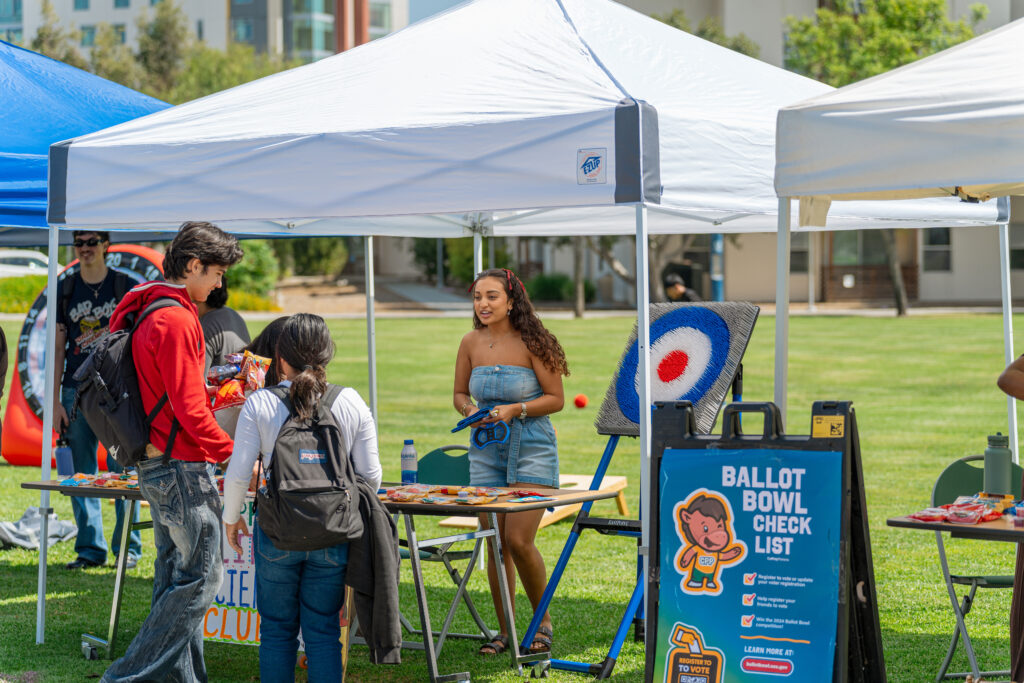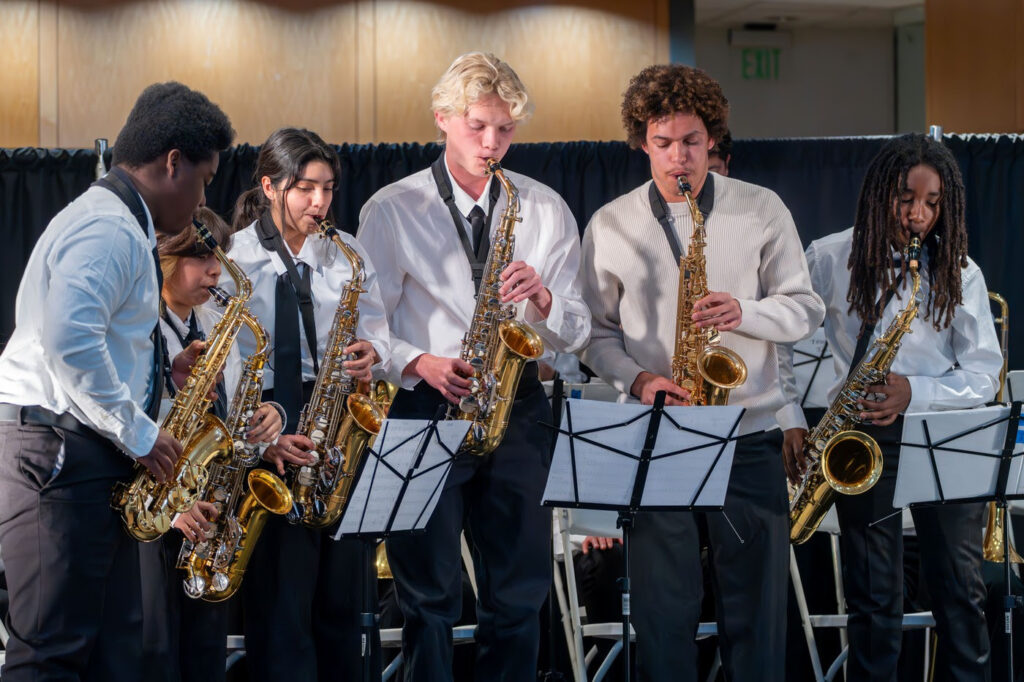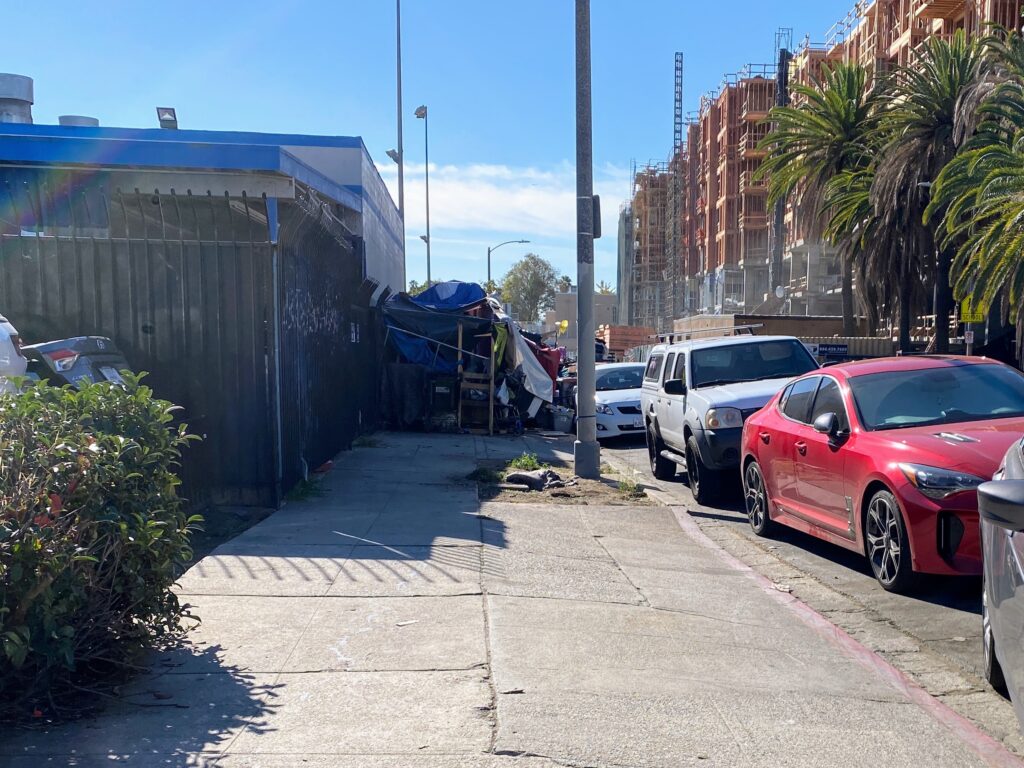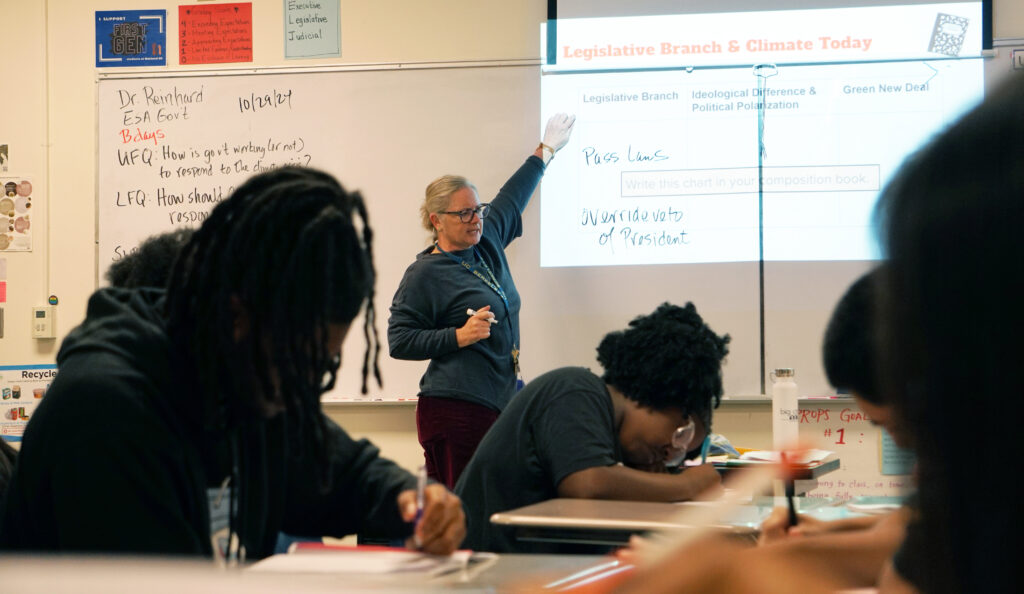
Elk Grove Unified director of elementary school education Jodi Boyle gets tips on how to use a canvassing app before she heads out in support of Measure N, a school facilities bond.
Diana Lambert/EdSource
California school board races, largely ignored by voters until the 2022 election, are again taking center stage. The California Teachers Association(CTA), the California Republican Party and other organizations have significantly ramped up efforts to help their favored candidates win local school board seats on Nov. 5.
On Saturday, teachers and other school employees dropped into the offices of the Elk Grove Education Association to receive last-minute instructions and pick up yard signs and union T-shirts before fanning out across the Sacramento County district to encourage residents to vote for a local school bond and union-supported school board candidates.
It is part of a larger effort by CTA to get its local unions more engaged in school board elections. For the last few months, California teachers have been attending rallies and canvassing neighborhoods to drop off door hangers and knock on doors. County Republican central committees, other conservative organizations, and in some parts of the state, charter school organizations are doing the same.
CTA President David Goldberg said the union is “absolutely” taking this year’s school board elections more seriously than it has in the past, and is counting on the engagement and popularity of its teachers to win local races. It is also trying to change the culture of local unions not being active in elections.
“We know that our popularity as educators and union educators is at an all-time high,” Goldberg said. “And just the words: … ‘I’m an educator in your community, and I’m asking you to vote for this person,’ just that alone, changes elections. I mean that’s the gift we have. So we just have to lean into it and use it much more than we have in the past.”
Before the 2022 election, the Republican Party, and some conservative organizations and churches, spent more than a year recruiting, training and endorsing candidates in an attempt to create a “red wave” to win what are supposed to be nonpartisan seats.
Their goal was to gain seats on California school boards to promote conservative ideas, including fighting educational policies on gender identity and racial equity. Although the effort made some headway, it failed to flip many seats in more liberal areas of the state.
This year, county Republican central committees and conservative groups, like the Leadership Institute, again recruited and trained school board candidates throughout the state with a focus on winning seats in more liberal areas of the state.

Conservatives are campaigning even more aggressively than they did two years ago, said Shawn Steel, the Republican National Committee member from California. “There’s been a lot less noise but a lot more action,” he said.
Both sides say power is the issue
Goldberg said that some of the conservative candidates running for school board are self-proclaimed “white Christian nationalists” who are part of a broader movement to dramatically change public education to suit their ideology.
“It’s not an attack on Christianity, what we’re saying,” Goldberg said. “Because this has very little to do with Christianity at all. It’s about power, and it’s about using power to really re-imagine public education in a way that does not include the majority of our students in that vision, but really is a fundamentalist attack on democracy.”
Steel says the teachers unions have too much power and that union members are trying to get candidates elected that they can control.
“You got the union reps that are literally knocking on doors and financing their candidate,” Steel said. “And why are they doing that? It’s not because they want education better, they want better salaries and more power. It should be illegal, in my view.”
How the union supports campaigns
As a rule, the CTA focuses its efforts on statewide races and propositions, while local unions support local races. But local unions can apply for financial support for school board races from the CTA Political Action Committee. The CTA and local teachers unions sometimes share the cost of joint mailers advertising statewide races on one side and local races on the other, Goldberg said.
“We’re never going to have enough money to fund these races,” Goldberg said. “We live in the fifth-largest economy in the world. We have billionaires who frankly could write a bigger check in a single day than 300,000 members could raise in years. So, our real power is our member strength. And our members and educators are trusted more than any other people.”
Over the next several years, the CTA is spending about $60 million so that every union president can be released from the classroom to engage with their members, including encouraging their members to participate in local campaigns, Goldberg said.

This is the first year Elk Grove Education Association members have canvassed neighborhoods for candidates. Teachers who were campaigning on Saturday credited the leadership of local union President James Sutter for getting Elk Grove teachers excited about supporting union-endorsed candidates and a local school facilities bond in the upcoming election.
Troy Morgan, science teacher at Monterey Trail High School, has been knocking on doors promoting union-endorsed candidates every Saturday since early September. He sometimes goes out after school on weekdays as well.
“I think we just realized how important it is, having a cohesive school board that supports students, and just knows how things should work, or what’s going to work best for students and all staff, not just teachers,” Morgan said Saturday before heading out for more canvassing. “There have been times in the past where it hasn’t been a cohesive kind of board, and we want to make sure that we have the kind of board that is going to be supporting all students.”
Elk Grove Unified teachers, wearing “Yes on N” T-shirts, have collectively knocked on about 7,000 doors since they started hitting the streets each Saturday since September, Sutter said.
Temecula teachers fight back
Goldberg recently walked for union-endorsed candidates running for the Temecula Valley Unified school board. The district in Riverside County has been in the media spotlight for more than a year for everything from rejecting textbooks with materials that included references to gay rights activist Harvey Milk, banning critical race theory and passing a policy requiring teachers and school staff to notify parents if a child appears to be transgender.
“That’s been turning our district a little upside down,” said union President Edgar Diaz. “Most of the board meetings have turned to focusing on these issues, instead of how do we address supporting students who are falling behind on the dashboard, who have IEPs (individualized education programs), who are English language learners? How do we develop systems that help them be successful in the classroom? So, in this election, it’s turned a lot into supporting candidates who believe in good governance.”
Tension over the policies of the conservative majority board led to the recall of board President Joseph Komrosky in June. Komrosky is running for one of the four available seats on the board in the upcoming election.
Two years ago, teachers at Temecula Valley Unified paid little attention to board races and campaigning, Diaz said. That all changed after a conservative majority was elected to the board in 2022. This year, members of the Temecula Valley Educators Association are sending out mailers, making phone calls and texting potential voters.
“Once they were elected and the policies and kind of chaos they brought into school board meetings, that is what got people motivated to do the work,” Diaz said.
The union’s political action committee recruited and interviewed candidates for endorsements and has spent about $60,000 total – $20,000 on each of three endorsed candidates. In 2022, the union spent $18,000 in total helping three candidates get elected.
Local teacher unions fund their PACs with donations primarily from their members. Temecula also received contributions from other union locals as well as money the union got from CTA, Diaz said.
Parental notification still on the ballot
School board policies directing school staff to notify parents if a student asks to use a different pronoun or name than given at birth — often called parental rights policies — continue to be a hot-button issue in some districts this election season, despite a new state law that will make these policies illegal starting in January.
The new state law requires a student’s consent before information about their sexual orientation or gender identity can be given to parents. The law also protects school staff from retaliation if they refuse to notify parents of a child’s gender preference.
In Yuba County, north of Sacramento, members of the Republican Central Committee attended school board meetings to evaluate whether school board trustees supported parent notification policies and, if not, whether they should be replaced in the upcoming election, said Florentina Di Gennaro, the treasurer of the committee.
“We kind of let them know if you’re not going to stand up for these things that we need to start happening in our schools or defending parents’ rights for our children, we are going to find someone to replace you,” Di Gennaro said.
The California Republican Party leaves funding and campaigning for down-ballot races to its county central committees, said Jonathan Zachreson, a candidate for the Roseville City School District board.
The Yuba County committee recruited and endorsed “Mama Bears” and “Papa Bears” to run for school board seats. Committee members wanted people who would push back against the new state law and other policies, Di Gennaro said.
The central committee is also attempting to replace Marysville Joint Unified Superintendent Fal Asrani because she won’t disregard the law. Asrani went on medical leave earlier this month. Di Gennaro said that a committee that will include a member of the GOP Central Committee will soon begin looking for a new superintendent.
Steel doesn’t agree with everything conservative board members have done since the last election. Some of the people elected to school boards in 2022 were wrongly focused on social issues instead of economic issues or fighting against diversity, equity and inclusion (DEI) policies, he said. Steel said that DEI policies are racist and punish students for their color, but he doesn’t agree with policies focused on LGBTQ+ communities, he said.
“That’s a mistake,” he said. “I think most folks don’t think that the gay community should be targeted and scorned. So, that’s something I think most of the folks have learned this time around, because it’s not something that most folks believe. It’s not a community that should be attacked.”
San Jose union protecting board seat
The San Jose Teachers Association has been recruiting candidates and helping them win elections for years, but this year the 1,500-member union is putting more energy and money into campaigning after seeing conservative organizations recruiting candidates for local school board seats, said Renata Sanchez, union president.
“We shared it (the information) with our smaller locals as well,” Sanchez said. “And we’re like, let’s get ready now because they’re coming for us next year. And now they’re here.”
One candidate running for San Jose Unified is being endorsed by the Santa Clara County branch of Moms for Liberty, a national group that has supported efforts to bar schools from teaching about race, gender and sexuality. Members of the organization and the Silicon Valley Association of Conservative Republicans also are endorsing the candidate, Sanchez said.
“So, we’re making sure that we protect our school board and protect our academic freedom, by making sure that she doesn’t get on,” Sanchez said.
The union is sending out mailers, buying digital advertising and recently launched a mass text-messaging campaign. It also has encouraged teachers to go on “block walks” in the neighborhoods around their campuses after the school day ends to talk to potential voters about union-backed candidates and a facilities bond that includes some funding for workforce housing. Groups of teachers also canvas neighborhoods every Saturday.
“The stakes are higher than they’ve ever been,” Sanchez said.
LA teachers take on charter proponents
Not all hotly contested elections are cultural. In Los Angeles Unified, the teachers union and charter school organizations are also battling over school board seats.
The union is running campaigns in two of the three school board races, endorsing and supporting a UTLA member — who will stop teaching if elected to the paid school board seat — and an incumbent it has endorsed in prior elections, said Julie Van Winkle, vice president of United Teachers Los Angeles. The incumbent is running against another UTLA member who has been an advocate for charter schools and is outspending the union candidate 3-to-1, she said.
“We are always outspent by the charter school candidates, and we anticipate that in our school board election in the Valley, we’re going to be outspent 7-to-1,” Van Winkle said.
The union political action committee that finances campaigns is funded by about $2 million in member contributions and additional funding from the American Federation of Teachers and the National Education Association, she said.
Because funding is limited, Van Winkle said it is more advantageous for UTLA to mobilize its 39,000 members to knock on doors and to talk to residents about the union’s endorsed candidates.
“People value teachers and respect teachers, and so we feel like our best strategy is just getting teachers to donate their time to go out and tell people about why it’s important to vote for our candidates,” Van Winkle said.
